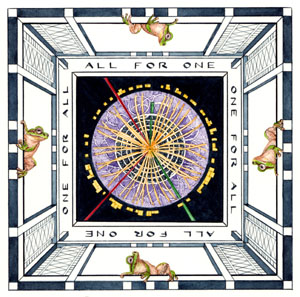
Philosophy Selections
Signed & numbered limited edition prints. Prints are offset lithographic reproductions of Susan Loy’s original watercolor.
Print Image Size: 6” x 6”
Susan Loy received permission from CERN, the world’s largest particle physics laboratory, to use Atlas photographs of Higgs Boson candidate events as models for her Higgs Boson Series. “Four Leptons” is her watercolor drawing of Event 12611816, Run 205113, recorded on June 18, 2012, H-> 2e2mu. Higgs bosons decay almost immediately into pairs of less massive particles such as leptons. Leptons are elementary particles that obtain mass through interactions with the Higgs field; there are six types of leptons, including electrons and muons. Loy’s drawing shows a zoom into the central part of the collider’s tracking detector. The four leptons are two muon tracks colored red and two electron tracks and clusters colored green; other tracks and deposits of energy are colored yellow.
Loy’s composition is a study in symmetry, an important tool in theoretical physics. Loy used several symmetry operations in her composition, including translation, rotation, reflection, and glide reflection. Dorsiventrality (left and right sides that mirror each other, a front and a back, and often a distinct top and bottom) is the abiding symmetry of the animal kingdom and is also common in the plant world. Loy chose The European tree frog, Hyla arborea, as an example of dorsiventrality and as a representative for all species, “one for all, all for one.”
Palindromes read the same backward or forward and are another example of symmetry. “All for one, one for all” or the inverse “One for all, all for one,” is an example of a word palindrome with all seven words elegantly matched up in three-letter lengths. Made famous by Alexandre Dumas’s novel of 1844, The Three Musketeers, (“Tous pour un, un pour tous,” spoken by d’Artagnan), the phrase was first recorded in 1618 and came into widespread use in the 19th century; it is the motto of Switzerland (“Unus pro omnibus, omens pro uno”) and appropriately reflects the spirit of collaboration demonstrated by the scientists from all over the world, working at CERN.
We have partnered with Amazon.com ~ you will enjoy the same price, quicker delivery, and lower shipping rates than we can offer in-house.
Four Leptons: Higgs Boson Series
H-> 2e2mu, Event 12611816

Print Paper Size: 10” x 10”
Frame Size: 12” x 12”

- Our Privacy Policy & Guarantee assure you a 100% safe and secure transaction!
- Return to Philosophy Selections
- Return to Math & Physics Selections
Use our SEARCH ENGINE if you are you looking for a Literary Calligraphy painting with a specific word or phrase!
Return to complete Online Catalog